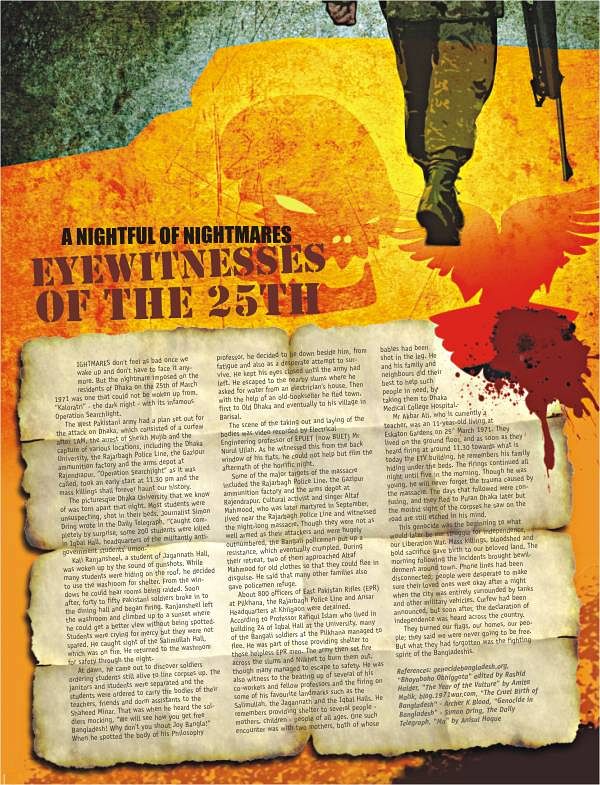
Story: Padya Paramita
Cover art: E R Ronny
Nightmares don't feel as bad once we wake up and don't have to face it anymore. But the nightmare imposed on the residents of Dhaka on the 25th of March 1971 was one that could not be woken up from. “Kaloratri” - the dark night - with its infamous Operation Searchlight.
The West Pakistani army had a plan set out for the attack on Dhaka, which consisted of a curfew after 1AM, the arrest of Sheikh Mujib and the capture of various locations, including the Dhaka University, the Rajarbagh Police Line, the Gazipur ammunition factory and the arms depot at Rajendrapur. “Operation Searchlight” as it was called, took an early start at 11.30 pm and the mass killings shall forever haunt our history.
The picturesque Dhaka University that we know of was torn apart that night. Most students were unsuspecting, shot in their beds. Journalist Simon Dring wrote in the Daily Telegraph, “Caught completely by surprise, some 200 students were killed in Iqbal Hall, headquarters of the militantly antigovernment students' union.”
Kali Ranjansheel, a student of Jagannath Hall, was woken up by the sound of gunshots. While many students were hiding on the roof, he decided to use the washroom for shelter. From the windows he could hear rooms being raided. Soon after, forty to fifty Pakistani soldiers broke in to the dining hall and began firing. Ranjansheel left the washroom and climbed up to a sunset where he could get a better view without being spotted. Students were crying for mercy but they were not spared. He caught sight of the Salimullah Hall, which was on fire. He returned to the washroom for safety through the night.
At dawn, he came out to discover soldiers ordering students still alive to line corpses up. The janitors and students were separated and the students were ordered to carry the bodies of their teachers, friends and dorm assistants to the Shaheed Minar. That was when he heard the soldiers mocking, “We will see how you get free Bangladesh! Why don't you shout Joy Bangla!” When he spotted the body of his Philosophy professor, he decided to lie down beside him, from fatigue and also as a desperate attempt to survive. He kept his eyes closed until the army had left. He escaped to the nearby slums where he asked for water from an electrician's house. Then with the help of an old-bookseller he fled town, first to Old Dhaka and eventually to his village in Barisal.
The scene of the taking out and laying of the bodies was video recorded by Electrical Engineering professor of EPUET (now BUET) Mr Nurul Ullah. As he witnessed this from the back window of his flats, he could not help but film the aftermath of the horrific night.
Some of the major targets of the massacre included the Rajarbagh Police Line, the Gazipur ammunition factory and the arms depot at Rajendrapur. Cultural activist and singer Altaf Mahmood, who was later martyred in September, lived near the Rajarbagh Police Line and witnessed the night-long massacre. Though they were not as well armed as their attackers and were hugely outnumbered, the Bangali policemen put up a resistance, which eventually crumpled. During their retreat, two of them approached Altaf Mahmood for old clothes so that they could flee in disguise. He said that many other families also gave policemen refuge.
About 800 officers of East Pakistan Rifles (EPR) at Pilkhana, the Rajarbagh Police Line and Ansar Headquarters at Khilgaon were detained. According to Professor Rafiqul Islam who lived in building 24 of Iqbal Hall at the University, many of the Bangali soldiers at the Pilkhana managed to flee. He was part of those providing shelter to those helpless EPR men. The army then set fire across the slums and Nilkhet to burn them out, though many managed to escape to safety. He was also witness to the beating up of several of his co-workers and fellow professors and the firing on some of his favourite landmarks such as the Salimullah, the Jagannath and the Iqbal Halls. He remembers providing shelter to several people - mothers, children - people of all ages. One such encounter was with two mothers, both of whose babies had been shot in the leg. He and his family and neighbours did their best to help such people in need, by taking them to Dhaka Medical College Hospital.
Mr Akbar Ali, who is currently a teacher, was an 11-year-old living at Eskaton Gardens on 25th March 1971. They lived on the ground floor, and as soon as they heard firing at around 11.30 towards what is today the ETV building, he remembers his family hiding under the beds. The firings continued all night until five in the morning. Though he was young, he will never forget the trauma caused by the massacre. The days that followed were confusing, and they fled to Puran Dhaka later but the morbid sight of the corpses he saw on the road are still etched in his mind.
This genocide was the beginning to what would later be our struggle for independence, our Liberation War. Mass killings, bloodshed and bold sacrifice gave birth to our beloved land. The morning following the incidents brought bewilderment around town. Phone lines had been disconnected; people were desperate to make sure their loved ones were okay after a night when the city was entirely surrounded by tanks and other military vehicles. Curfew had been announced, but soon after, the declaration of independence was heard across the country.
They burned our flags, our homes, our people; they said we were never going to be free. But what they had forgotten was the fighting spirit of the Bangladeshis.
References: genocidebangladesh.org, "Bhoyaboho Obhiggota" edited by Rashid Haider, "The Year of the Vulture" by Amita Malik, blog.1971war.com, "The Cruel Birth of Bangladesh" - Archer K Blood, "Genocide in Bangladesh" - Simon Dring, The Daily Telegraph, "Ma" by Anisul Hoque
